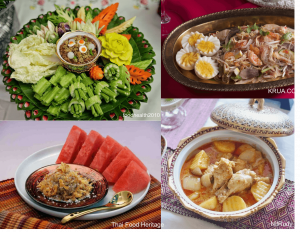Thai royal cuisine can be defined, in the traditional sense, as food cooked in palaces to serve members of the royal family. For a large part of Thai history, the royal palace served as a center of trade and administration. People from all corners of the kingdom came to serve under the monarch and his family, while goods from all over the world find their way to the royal kitchen. Royal dishes included savory and dessert components much like the commoners, but with more detailed preparations and presentations. Many dishes are variations of local specialties that have been rearranged to suite the delicate taste of court life. Other dishes are adaptations of foreign dishes, made with Thai ingredients.
The two components of royal Thai cuisine are taste and presentation. Royal dishes are known for their layered and well-balanced flavors. Spicy dishes are never overtly spicy, while sweet dishes are balanced with saltiness. A special focus is also given to the scent of food, which must compliment and bring out the ingredients. Aesthetic in presentation is achieved through the arrangement of the food themselves and the vessels they are served in. One famous culinary technique that originated within palace walls is fruit and vegetable carving. Dishes are commonly served in metallic vessels made from precious materials or ceramics depicting detailed patterns and vibrant colors. Due to the strict etiquette of the royal court, the dishes are also crafted to be easily consumed down to every single bite in order to prevent messy eating.
Traditionally, recipes are developed and passed down by the ladies of the court. An important transition came with the publication of the Mae Khrua Hua Pa (แม่ครัวหัวป่า) cookbook written by Than Phu Ying Phasakorawong in 1908, detailing recipes for royal dishes. After that, royal culinary traditions are taught in both formal and non-formal (from mother to daughter) settings. Royal dishes became available for the public to enjoy and many components of royal culinary presentation became an important aspect of the hospitality factor in Thailand’s tourism industry.
Famous dishes of royal origins include: nam phrik long ruea (น้ำพริกลงเรือ) – chili dip on a boat, pla haeng tang mo (ปลาแห้งแตงโม) – fish flakes with watermelon, and yum yai (ยำใหญ่) – multi-ingredients salad.

From top right: 1. nam phrik long ruea 2. yum yai 3. pla haeng tang mo 4. Massaman curry
Source:
“Thai Gastronomy from Home Kitchen to Royal Cuisine” By Kukanya Sujachaya (2018)
Written by: Tayud Mongkolrat


